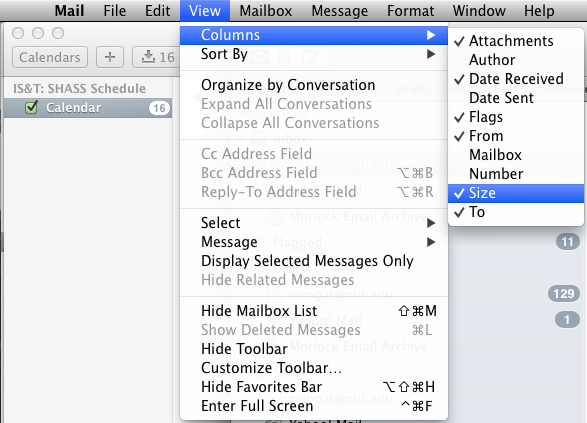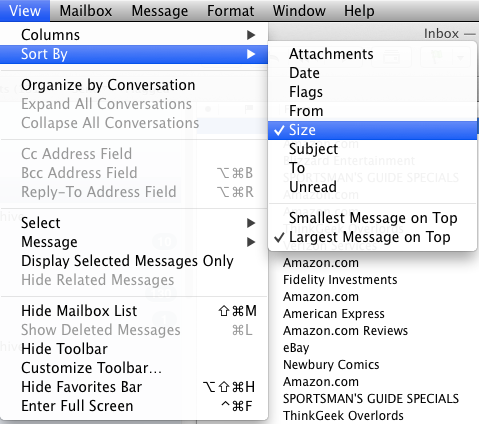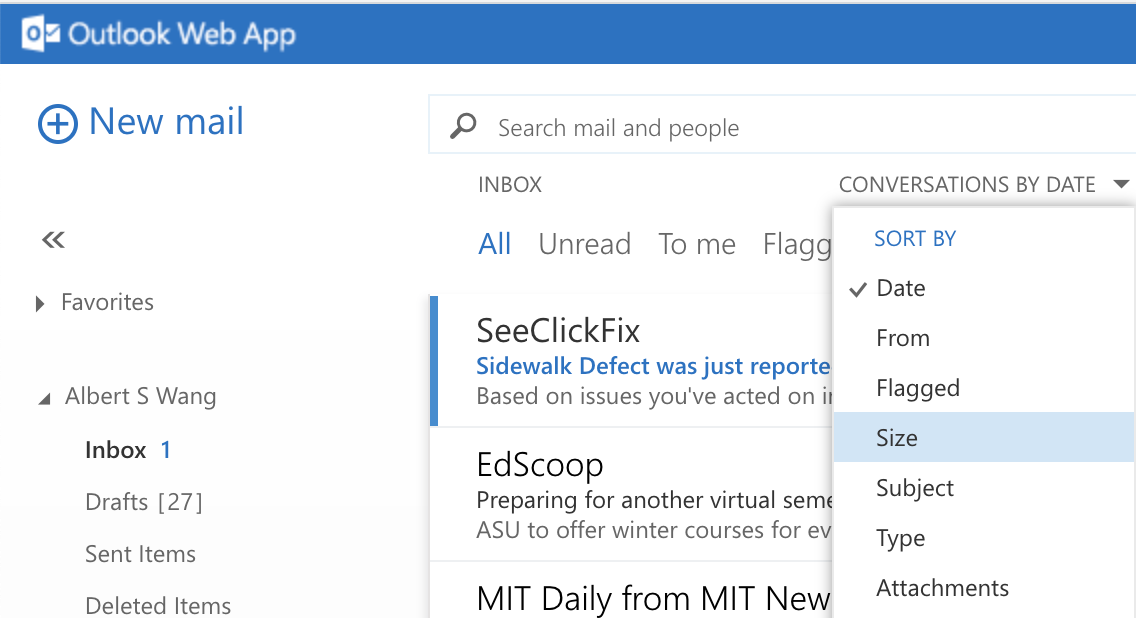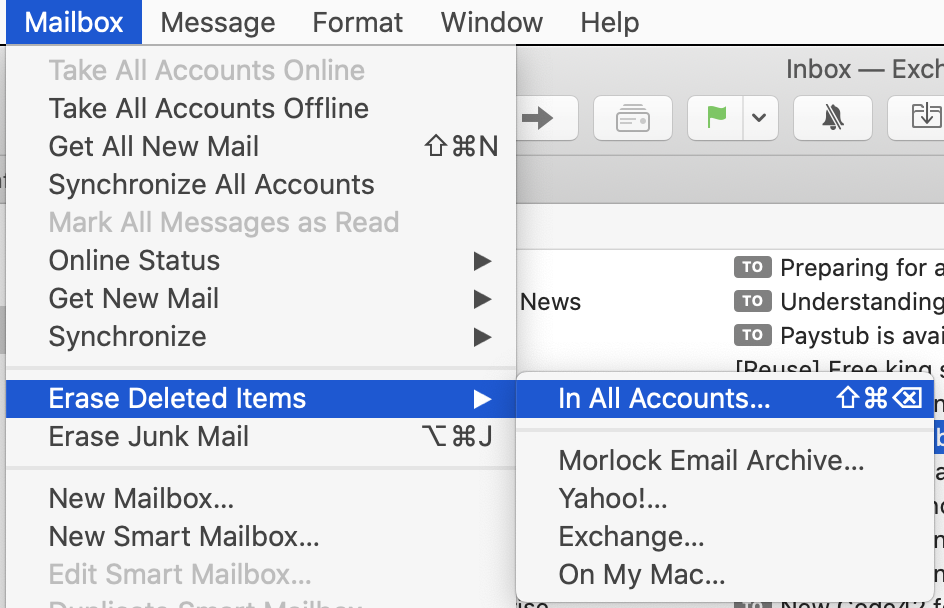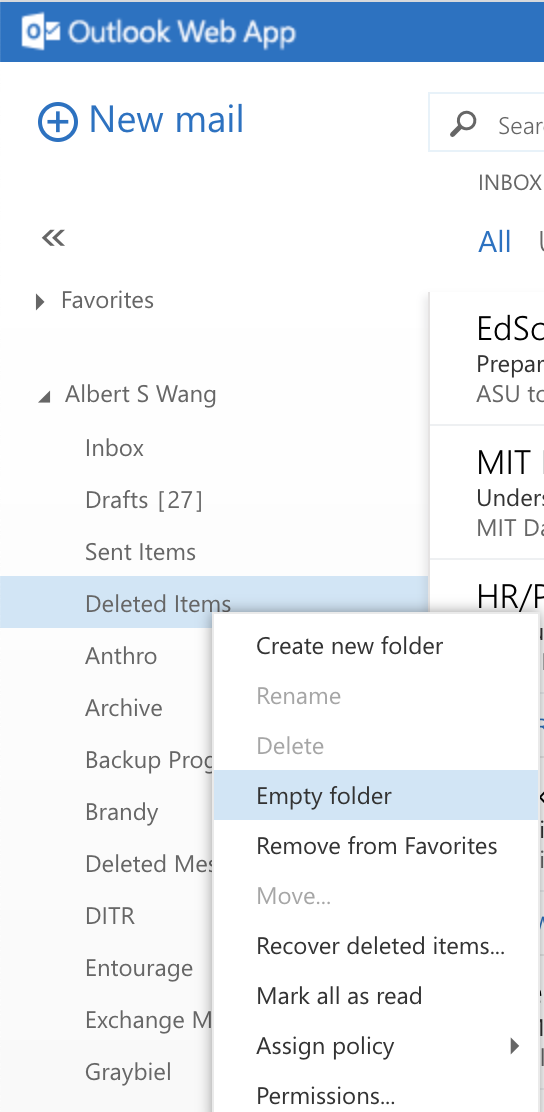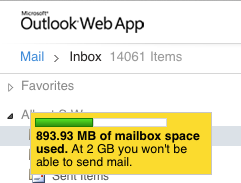The Exchange Email system that MIT uses has a lot of nifty features but there are also key steps users can take to properly care for your email in order to keep your Exchange email and calendaring happy.
How To Keep Your Disk Usage Down
Turning on the size column
One of the most useful tools for deciding which emails to delete first is the size column in Apple Mail. This column allows you to see how big an email is and which emails are consuming most of your disk quota.
To enable this, go to View -> Columns -> Size
When the Size attribute is checked, the column for email size will appear in your main Apple Mail window view.
Deleting unwanted emails
For most users there is no reason to keep everything you recieve in email. The easiest way to maintain low disk usage in your email is to view your emails by size.
To do this in Apple Mail:
To do this in OWA click on "Conversations By Date" and select "Size".
Once you're set your emails to sort by largest emails first you can then save the large attachments and then delete the large emails you don't need. This strategy will give you the most bang for the buck in freeing up the most space in your email for the least amount of work.
Once you've removed all the large emails, you can then view your emails by subject and, for example, if you get marketing emails from Amazon or Ebay, you can sort by subject and delete all of these emails at once if they use the same subject pattern.
Don't forget afterwards that you need to go to Mailbox-> Erase Deleted Items-> In All Accounts... to actually delete the emails and free up your email quota.
In OWA:
On a 2 button mouse, Left CLICK
OR
On a 1 button mouse, Control-CLICK
on "Deleted Items" and select "Empty Folder" to dump all of your deleted items.
Then after you've erased deleted items in all your accounts, you can set your email back to view your emails by date.
Archiving Emails Locally
Apple Mail on Macs
In the left column in Apple Mail is a section called "On My Mac". Any email folders and emails copied and pasted or dragged into this section is stored locally on the machine. Users can copy and paste emails from their Exchange inboxes into the folders in "On My Mac" to create a local archive of the emails. Keep in mind, however, that any emails you put here will ONLY be available in this particular local machine. This may not work if you require your archives to be available on all the machines you use.
Please contact us if you need ideas for a more distributed Mac Apple Mail archive solution. As a general practice, syncing programs like Busy Sync are not recommended because of their latent instability once the program enters an irrecoverable failure mode.
There are is also a known issue with Apple Mail for users with tons and tons of emails. Users with historical emails going back years should consider archiving emails older than say 5 years and taking those emails permanently offline. Both the size of emails and sheer quantity (hundreds of thousands) can cause Apple Mail to pinwheel or not properly display or locate those emails in searches. Sometimes it can take a really long time for those emails to come up. For the Exchange email system such as the one we now use here at MIT, the only client program that can successfully handle this kind of volume (hundreds of thousands) of emails is Microsoft Outlook 2010 or later on Windows 7 or 8.
Please be aware that Microsoft did not make Outlook on the Mac the same way Outlook on Windows works (with separate pst files instead of one giant proprietary data file). As a result, it is a less reliable program than its Windows counterpart.
Outlook 2011 on Macs
With few exceptions, we do not recommend anyone use Outlook 2011 for Macintosh as their email client to access their MIT Exchange email and calendaring. Outlook 2011 lacks the external file features (mbox or pst files) found in both Apple Mail for Mac OS and Outlook 2010 for Windows which would make recovery from a failure straightforward and easy. Instead, Outlook 2011 for Mac stores all emails and calendaring data in one massive proprietary database that cannot be recovered once the database becomes corrupted. What's worse the chances for data corruption and actual performance degradation increases with the size of the data base. It is therefore critical if you are one of the few exceptions using Outlook 2011 that you have at minimum a working Time Machine backup on your machine.
Outlook 2010 on Windows
Microsoft Outlook 2010 has a nifty feature enabling users to create a .pst file to store emails locally on a Windows PC. Microsoft has some instructions on how to do this here:
http://office.microsoft.com/en-us/outlook-help/create-an-outlook-data-file-pst-to-save-your-information-HA010355677.aspx
MS Outlook 2010 users should also be aware that .pst files should not exceed 2GB in size. If your email archives are becoming too large you should break them up to keep these pst files under 2GB. Some instructions from Microsoft on how to manually manage this can be found here:
http://office.microsoft.com/en-us/outlook-help/archive-items-manually-HA010355564.aspx
Storing your emails- what NOT to do
Users should never never NEVER store their emails in the trash. I can not tell you how many times this has ended badly and how much of a truly bad, awful idea this is. It is absolutely CRITICAL that if you have emails that you think you might need, create a folder called "Unsorted" or "Not Trash" so you can put them in for later viewing. NEVER store email in the trash. You don't store food, or anything you may want in the trash so don't put your emails there either.
Managing Your Email Quota
If you get a legitimate email from IS&T (assuming it's real and not a phishing email) indicating that you're out of quota in your Exchange account, the first thing you should do is launch a fresh browser window in Firefox and log into owa.mit.edu . Once you're logged in, OWA will be able to tell you if you're over quota as there will be a big warning box in the upper left corner of your web window.
The standard Email quota for Exchange users is 2GB. Sometimes research projects or administrative functions require users to keep more emails on record than the system may initially allow. To request a quota increase to 4GB, you can send an email to network-exchange@mit.edu asking for the quota increase up to 4GB. For more space than this, you may need your AO or section head to make the request to network-exchange@mit.edu .
Checking your Quota BEFORE you're out of space
To check your quota before you're you're out of space, log into owa.mit.edu and move your mouse carefully over your name in the left column and wait 1-2 seconds. A yellow box with your current disk space quota usage should appear. If you accidentally move your mouse while the yellow box with your current usage is showing or accidentally click the mouse, the box will go away. To get it back, you will have to move your mouse away from your name about 3-5 seconds (sometimes you will need to click on a blank spot in the owa window to get it to "reset") and then move your mouse slowly back to your name and wait 1-2 seconds to get the yellow box showing your current disk quota usage to come back up.
IMPORTANT: If you max out your quota, you will not be able to send mail. Depending on how badly you're over your quota you may not be able to delete email either. Should you encounter this situation, you or your IT Tech liaison, or your AO will need to contact IS&T directly to have your quota increased either temporarily or permanently to fix this issue. Requests for permanent quota increases should ideally be made to IS&T by the AO or section heads.
A sample of what this looks like is here:
Email sizes
Please note when sending and receiving email there is a maximum email size of approximately 30MB per email on the MIT Exchange email servers. This assumes both sender and recipient are on the MIT Exchange email system.
http://kb.mit.edu/confluence/pages/viewpage.action?pageId=4270408
Please note however that other email systems outside of MIT may have lower or higher limits depending on their system.
Calendaring
There are a number of preventative measures people who use the Exchange calendaring need to be aware of in order to keep your calendar happy.
- All repeating events MUST have an END DATE. NEVER create a repeating event without an end date. Doing so could result in a really unhappy calendar that is slow, hangs, and pinwheels.
- If you get an error while creating or modifying an event, ALWAYS REVERT TO SERVER if that option is presented. This is the only right answer. If you click on anything but REVERT TO SERVER, your Calendar will go offline permanently and any events you create will never get added to the Exchange calendar. You will need to create or re-edit the event again but at least you will stay online and the changes will go through the second time. There is an unusual bug with the Exchange server especially with iCal where the user can try to create or modify an event before the Exchange server has had a chance to write to the Exchange calendar. This bug was widely reported in Apple OS 10.7 and 10.8. In 10.9 the issue still occurs but considerably less frequently in our experience.
- When running your calendar, always check to make sure the calendar is online. In iCal as long as you don't see the triangle alert symbol to the right of the calendar name, your calendar is online. Offline calendars pose 2 critical issues:
- There is no network connectivity in the area which means your calendar won't actually get updated.
- There is already a bad calendar event in place which is forcing your calendar offline. In this situation, you will need to delete the bad event before your calendar can be taken back online. In our experience, bad events are usually repeating events that have no end date or are the most recent event you created that returned an error from the Exchange server but didn't click REVERT TO SERVER for.
- NEVER ever use BOTH Outlook 2011 and Apple Mail on the same machine checking the same email account. Doing so can cause both mail apps to fight and can cause slow behavior, hangs, and pinwheeling on the Mac.
- If you are an Outlook 2011 user, NEVER use sync services. Make sure Sync Services stays off. This module in conjunction with 4 has caused more than a few problems on user machines causing massive slow downs and pinwheeling.
Spam filtering
We do not recommend users activate the local client spam filtering in Apple Mail or Outlook. These filters will only work on the specific machine you're on and do not stop spam on any other computer or device you check email on or on MIT's OWA webmail. Instead, users should manage spam with Spam Quarantine. Spam Quarantine stops spam mail before it gets to your Exchange email account. We have set up a page describing how to use this service here.
